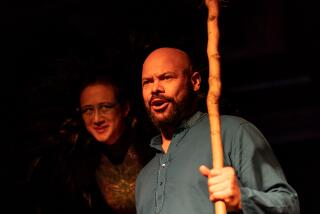Becoming lost can be a wondrous thing
- Share via
Toward the end of her latest book, an intriguing amalgam of personal memoir, philosophical speculation, natural lore, cultural history and art criticism, San Francisco-based writer Rebecca Solnit remarks: “A man once told me that much of my writing was about loss ... and I thought about that comment for a long time.”
As a historian, Solnit reflects, she feels strongly committed to retrieving lost material from the past, to prevent it from slipping away. As a close observer of the natural world that sustains us all, she is disturbed by the multitude of things that are “vanishing without replacement in our time.” That last phrase -- “vanishing without replacement” -- is key to Solnit’s thinking in “A Field Guide to Getting Lost,” because in it she demonstrates that she is perfectly well aware that loss takes many forms, not all of them necessarily bad.
Indeed, beginning with the first chapter, “Open Door,” Solnit writes in praise of loss, or rather, of what she calls “getting lost.” One can get lost in a story, lost in thought, lost in the arms of love, lost in a city, lost in the immensities of the world of nature. Recalling the door left open for the prophet Elijah during the Seders of her Northern California childhood, Solnit contrasts the freedom she had to wander and explore her surroundings with the tense and circumscribed way -- cellphones, over-programmed schedules -- in which many children (and adults) are living today.
Becoming lost, she feels, can be a wondrous thing, allowing one to expand the confines of one’s identity and undergo a transformation, an enlightenment. In support of this idea, she cites lovely and suggestive passages from sources as various as Walter Benjamin, Virginia Woolf, Henry David Thoreau, the Wintu Indians and the pre-Socratic philosopher Meno.
In four more quasi-autobiographical chapters, Solnit uses further aspects of her life as starting points for her wide-ranging reflections. “Daisy Chains” contemplates the difficulties of pinning down solid information on her immigrant grandparents. “Abandon” focuses on the time Solnit came of age, the punk era of the early 1980s, and the fate of a close friend -- wilder, less cautious than Solnit -- who lost her life.
“Two Arrowheads” recounts Solnit’s love affair and sojourn with a man who lived in the Mojave Desert, then segues into reflections about Hitchcock’s 1957, San Francisco-based movie “Vertigo” and, more interestingly, her abandoned plan for an alternate version shifting the focus to San Francisco’s then-burgeoning Beat scene. In the concluding chapter, “One-Story House,” Solnit revisits the much-altered site of her childhood home and comes to appreciate her environmentalist father’s efforts to preserve the landscape and wildlife of the Marin Peninsula.
Interspersed with these five personal tales are four chapters, all bearing the name “The Blue of Distance,” one about 15th century painters’ use of that hue, another about the wildly eccentric 20th century blue-obsessed artist Yves Klein, another (more mundane) about the sad, blue qualities of country and western music, and (the most fascinating and beautiful) about the 16th century Spanish conquistador Cabeza de Vaca, who came to Florida in search of gold, became lost in the wilderness and was profoundly transformed by years of wandering that brought him as far west as New Mexico.
A lover of art, cities and nature and an award-winning author of eight previous books, including “Wanderlust: A History of Walking” and “As Eve Said to the Serpent: On Landscape, Gender, and Art,” Solnit is a distinctive and original writer. Thoughtful and literate as she is, she lacks the degree of intellectual rigor of a Simone de Beauvoir or a Marilynne Robinson, which is not, however, to suggest that she lacks judgment, common sense or the ability to draw subtle and important distinctions. And although one might hesitate to call her a consummate prose stylist, her expressive, often beautiful writing finely conveys the force of her insights and vision.
For the intrepid Blakean “mental traveler” as well as for travelers of the physical realms, “A Field Guide to Getting Lost” is a book to set you wandering down strangely fruitful trails of thought.
Merle Rubin is a contributing writer to Book Review.
More to Read
Sign up for our Book Club newsletter
Get the latest news, events and more from the Los Angeles Times Book Club, and help us get L.A. reading and talking.
You may occasionally receive promotional content from the Los Angeles Times.










